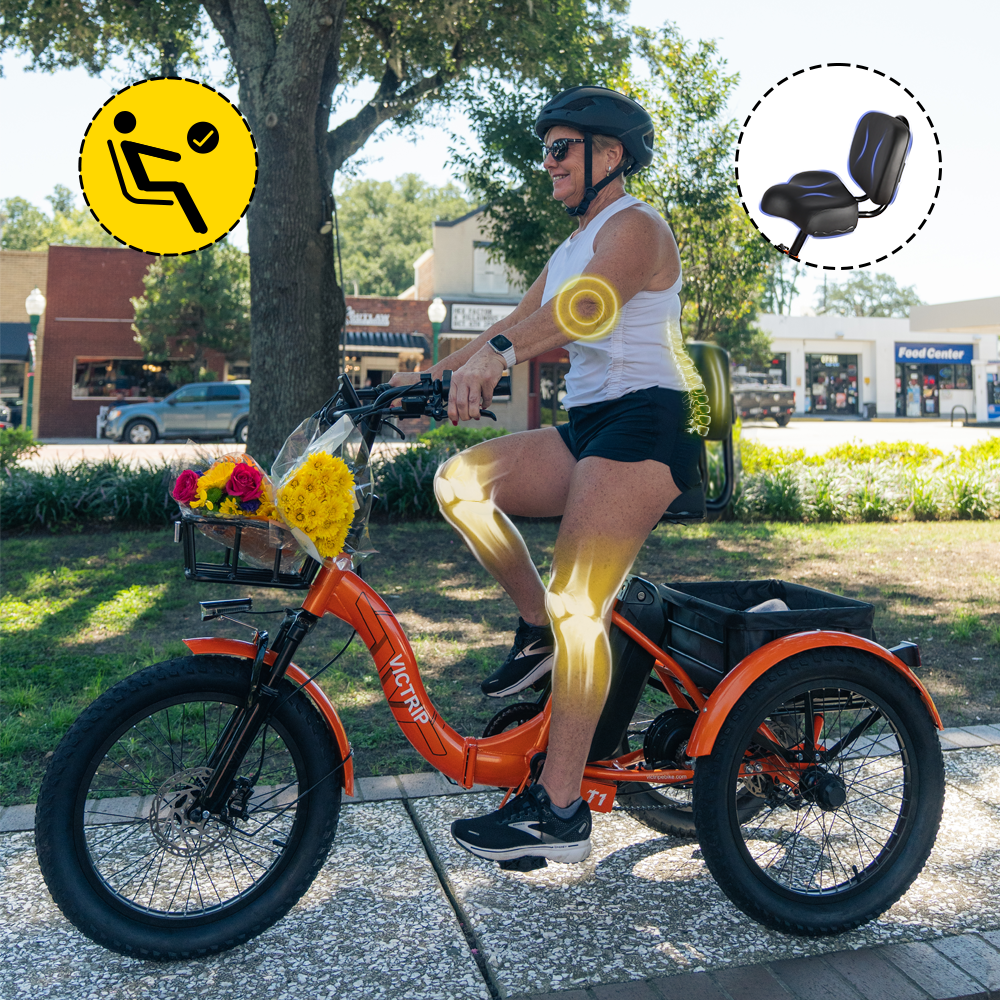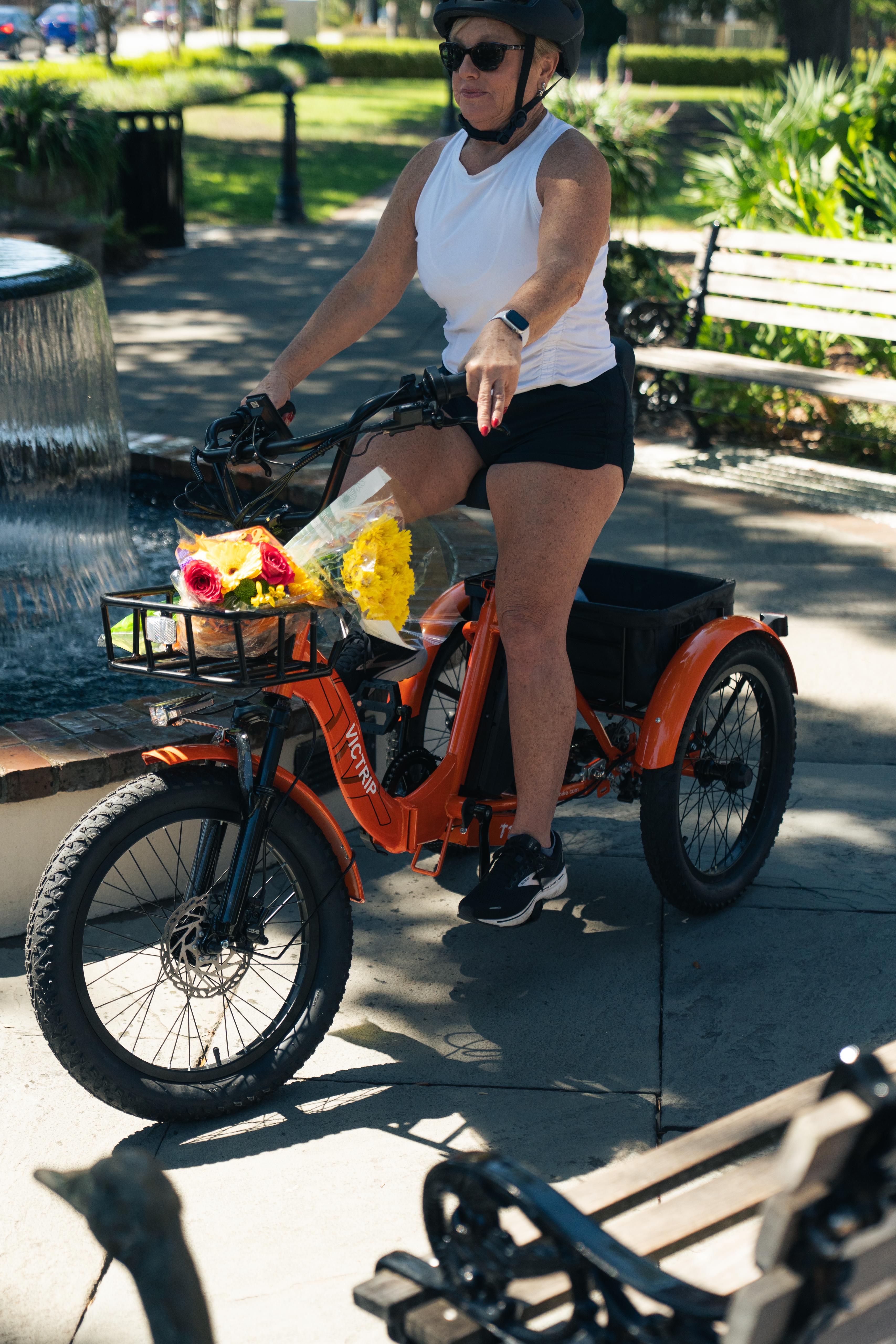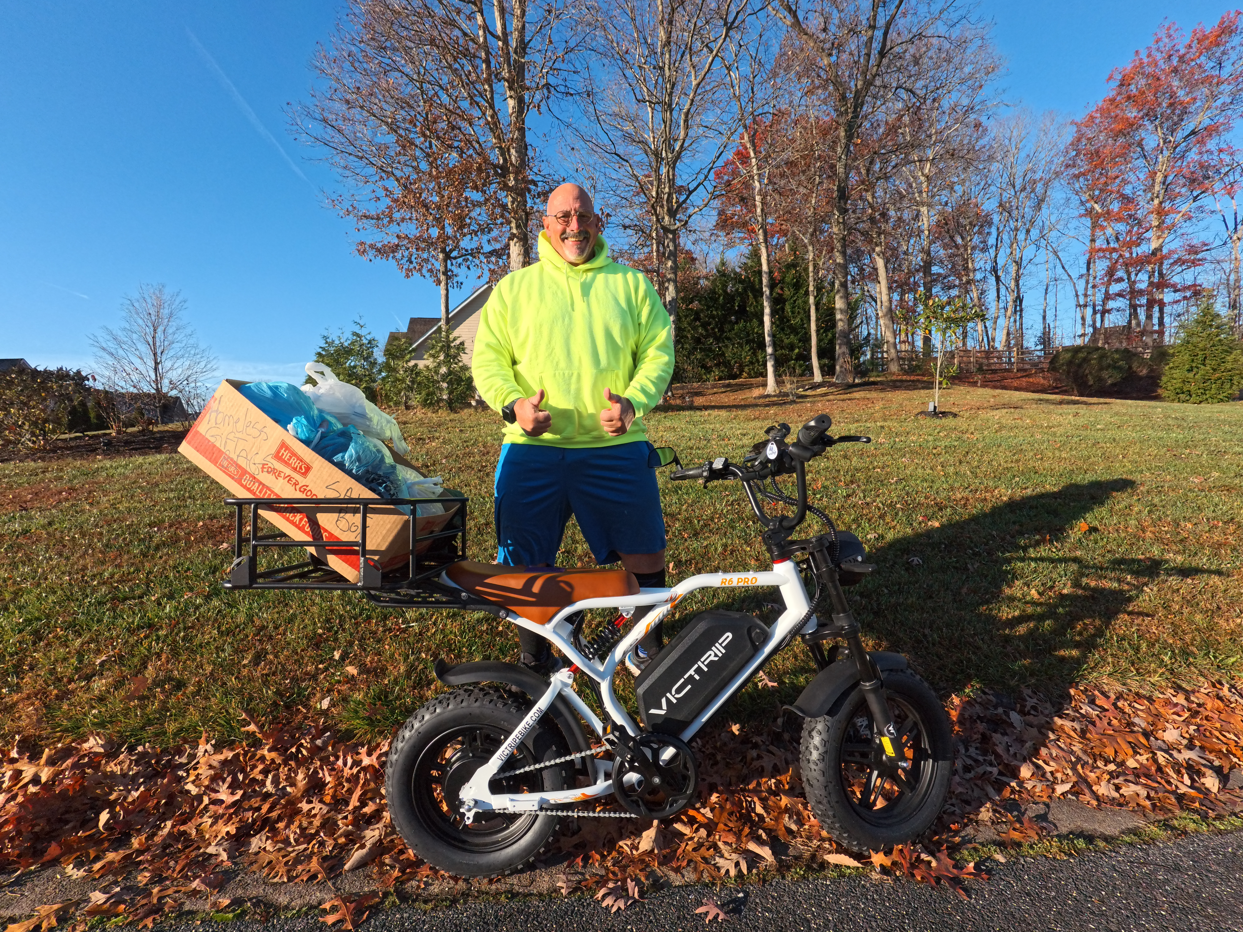Riding an electric tricycle isn't just a fun way to get around — it's also a surprisingly effective form of exercise. In this article we'll explore 8 Health Benefits of Riding an Electric Tricycle, showing how this accessible activity can support your heart, joints, muscles, balance, and mental well-being. Whether you're easing back into exercise, seeking low-impact options, or just wanting more outdoor time, an electric trike offers a blend of mobility and health that few devices match.
Electric tricycles combine pedal power with motor assistance, making it easier to ride longer, climb hills, and ride more often. Because they're stable and forgiving, they lower barriers for older adults, people with balance issues, and anyone recovering from injury. We'll go deep into each benefit, explain why it works, and give practical steps to make riding part of your daily routine.
How Electric Tricycles Work
Electric tricycles (e-trikes) typically pair a rechargeable battery with a motor that either assists pedaling (pedal-assist) or provides throttle power. The rider chooses how much assistance they want. There are upright trikes, recumbent trikes, and cargo trikes — each trades off comfort, speed, and maneuverability.
Key Components
-
Motor: Usually hub or mid-drive; powers the wheels.
-
Battery: Determines range; lithium-ion is standard.
-
Controller: Lets you choose assistance level.
-
Frame & Seat: Provide comfort and adjustability.
-
Brakes & Gearing: Important for safety and efficiency.
Because the motor reduces the physical load at times, riders can control intensity — making the ride either gentle or moderately challenging. That controllability is what enables many of the health benefits we’ll describe.
Benefit 1: Low-impact Cardiovascular Improvement
One of the biggest surprises about e-trike riding is how well it supports heart health. Even with motor assistance, pedaling raises heart rate, improves circulation, and trains the cardiovascular system.
Why it works:
-
Pedaling engages large muscle groups (quads, glutes), which increases oxygen demand.
-
You can sustain moderate effort longer than on a conventional bike because the motor helps on hills and into headwinds.
-
Regular rides (30–60 minutes, most days) align with widely recommended activity levels for cardiovascular benefit.
Practical tip: Use moderate assistance so your heart rate sits in the aerobic zone (roughly 50–70% of max for most adults). A short warm-up and cool-down will protect the heart and reduce soreness.

Benefit 2: Improved Joint Mobility and Reduced Pain
E-trikes are low-impact. Unlike running, which delivers repeated high forces to ankle, knee, and hip joints, pedaling moves joints through a smooth, controlled range.
How this helps:
-
Gentle, rhythmic motion lubricates joints, can relieve stiffness, and maintains range of motion.
-
Because the trike supports your weight and balance, you can exercise without painful load on knees or hips.
-
Workers in rehab settings often prescribe cycling or tricycle riding to build motion tolerance and reduce chronic joint pain.
Who benefits most: people with osteoarthritis, post-operative patients (with clinician approval), and anyone who finds high-impact exercise painful.
Benefit 3: Mental Health and Mood Boost
Outdoor movement brightens mood. Riding an electric tricycle combines physical activity with time spent outside — a strong recipe for mental health gains.
Mechanisms:
-
Exercise releases endorphins and neurotransmitters such as serotonin and dopamine.
-
Time outdoors reduces rumination and increases vitamin D exposure (where safe).
-
The independence that comes with reliable mobility reduces stress and increases self-efficacy.
Small but powerful: even short, regular rides around the neighborhood can lower anxiety, lift mood, and improve sleep.
Benefit 4: Enhanced Balance & Coordination
Though tricycles are inherently stable, riding them still improves coordination. Steering, shifting, and adjusting speed engage proprioceptive systems (the body's sense of position).
Why balance improves:
-
Regular use strengthens the neuromuscular pathways that coordinate movement.
-
Standing transfers (mounting/dismounting), turns at low speed, and negotiating slopes provide light balance challenges without high fall risk.
The VICTRIP T1 enhances this benefit with its ergonomic geometry and responsive handling, giving riders just enough feedback to engage stabilizing muscles while maintaining confidence and security. This makes e-trikes, especially the VICTRIP T1, particularly useful for older adults who want to train balance safely.
TOP PICK

VICTRIP® T1 Foldable Electric Tricycle
Benefit 5: Increased Muscle Strength & Endurance
Pedaling works the legs, glutes, and core. Over time, even assisted pedaling builds muscular endurance and strength.
Muscle groups targeted:
-
Quadriceps & Hamstrings: Primary drivers of the pedaling motion.
-
Gluteal Muscles: Power generation during strong pushes.
-
Core Muscles: Stabilize posture and steering.
-
Upper Body: Less so, but cargo trikes or heavy steering can engage arms and shoulders.
Progression strategy: gradually reduce assistance, increase ride duration, or add resistance intervals to build strength safely.
Benefit 6: Safer Option for Older Adults & Rehabilitation
Electric trikes offer more stability and easier access than two-wheel e-bikes. The three-wheel design reduces the risk of tipping and eliminates the need for complex balance skills.
Applications:
-
Rehabilitation programs for mobility recovery.
-
Older adults who want independence without the risk of falls.
-
Those with vestibular issues who still want aerobic activity.
Clinical note: anyone using an e-trike for rehab should do so under or following professional advice when recovering from serious injury.

Benefit 7: Encourages Regular Outdoor Activity & Socialization
Health is easier when it’s social. Riding an e-trike can be a social habit: neighborhood rides, group outings, or errands become invitations to move more.
Behavioral benefits:
-
Reduced friction: carrying groceries or a pet in a cargo trike makes active travel practical.
-
Social reinforcement: riding with friends increases adherence to routine.
-
Habit formation: short commutes or errands by trike become consistent opportunities for exercise.
Small change, big payoff: swapping one car trip a week for an e-trike ride builds fitness over months.
Benefit 8: Accessible Exercise Leading to Weight Management
Because e-trikes lower entry barriers, they help people stick with activity — a key to weight control. While calorie burn for assisted rides is lower than intense non-assisted cycling, steady, frequent rides still contribute meaningfully.
Practical numbers (estimates vary by intensity and rider weight):
-
A moderate 45-minute assisted ride may burn 200–400 kcal.
-
Increase frequency and reduce assistance to raise total energy expenditure.
Combine rides with modest dietary changes for reliable weight outcomes.
Quick Benefits Table
| Benefit | What it helps | Practical tip |
|---|---|---|
| Cardiovascular | Heart health, endurance | 30–60 min, moderate assistance |
| Joint mobility | Knee/hip pain relief | Keep cadence steady, avoid jolts |
| Mental health | Mood, stress reduction | Morning or evening nature rides |
| Balance | Proprioception, coordination | Practice turns & low-speed control |
| Muscles | Strength & endurance | Add intervals, reduce assistance over time |
| Safety/rehab | Low fall risk, therapy use | Consult clinician when recovering |
| Social activity | Adherence | Join local ride groups |
| Weight management | Calorie burn & habit | Use trike for errands to increase frequency |
Safety Tips and Best Practices
Riding safely keeps the health benefits coming. Follow these simple rules:
-
Wear a properly fitted helmet.
-
Start slow: short rides build tolerance.
-
Check tire pressure, brakes, and battery before each ride.
-
Use lights and reflective gear at dawn/dusk.
-
Avoid risky routes; choose quiet streets or bike paths.
-
Adjust assistance so you still get a mild workout.
-
If you have chronic health conditions, consult a clinician before starting.
Maintenance Checklist
-
Battery care: Charge after longer rides and avoid full discharges; store at moderate temperature.
-
Tire pressure: Check weekly.
-
Brakes: Inspect pads monthly; replace when worn.
-
Chain & drivetrain: Clean and lubricate per manufacturer guidance.
-
Fasteners: Check bolts and racks every month.
Choosing the Right Electric Tricycle
Picking an e-trike depends on your needs: commuting, cargo, fitness, or rehab.
Key features to evaluate:
-
Motor power: 250W–500W covers most needs; heavier riders or hilly terrain benefit from higher power.
-
Battery range: Choose a battery that exceeds your usual trip length by 25–50%.
-
Seat comfort: Test saddle ergonomics; adjustable seats reduce strain.
-
Step-through vs high frame: Step-through helps ease mounting.
-
Cargo capacity: For errands or pet transport, prioritize cargo options.
-
Brakes: Disc brakes for reliable stopping in varied weather.
Buying Checklist
-
Try before you buy: test ride with cargo and up a gentle hill.
-
Confirm weight capacity and warranty.
-
Ask about service centers and spare parts availability.
-
Prioritize comfort and ease of use over flashy extras.
Integrating E-Trike Rides into Daily Life
Consistency beats intensity. Here are practical ideas:
-
Use the trike for short errands (groceries, library).
-
Replace one short car trip per week with an e-trike ride, then increase.
-
Schedule three 30- to 45-minute rides per week — morning or evening.
-
Combine social time and exercise: invite a neighbor for a weekly loop.
-
Keep the trike near your door to reduce activation energy.
Micro-habits: leave a small checklist by the door (helmet, lights, wallet) — this reduces friction and makes riding automatic.

Conclusion
Electric tricycles are more than mobility devices — they’re practical health tools. The 8 Health Benefits of Riding an Electric Tricycle include cardiovascular improvement, joint relief, mental uplift, balance training, muscle strengthening, safer rehab options, social engagement, and accessible weight management strategies. Because e-trikes reduce common barriers to exercise — balance, fatigue, and transport logistics — they help people adopt consistent, long-term movement habits that matter most for health.
Start small, pick a comfortable trike, and build rides into your week. You’ll likely notice better mood, easier movement, and more confidence on short timelines. If you have medical conditions, run your plans by a professional; otherwise, enjoy the ride and the many healthy returns it brings.
FAQs
Is riding an electric tricycle good exercise if the motor helps most of the time?
Yes. You control assistance levels. Using moderate assistance still requires sustained pedaling and raises your heart rate. Over time you can reduce assistance to increase the workout. Even with generous assistance, regular riding improves stamina, mobility, and mood.
Can older adults with balance issues safely ride an electric tricycle?
Generally yes. Tricycles offer more stability than bicycles, reducing fall risk. However, it's wise to start gradually and, when relevant, consult a healthcare provider — especially if recovering from a serious condition.
How many calories can I burn riding an e-trike?
Calorie burn depends on weight, speed, and assistance. A moderate 45-minute ride may burn roughly 200–400 kcal. Reducing assistance or increasing intensity increases energy expenditure.
Do electric tricycles need a lot of maintenance?
Maintenance is similar to e-bikes: battery care, tire pressure, brakes, and drivetrain checks. Regular, modest upkeep prevents major issues. Follow the maker’s maintenance schedule.
Are there types of people who shouldn’t use an e-trike?
Most healthy adults and many people in rehab can benefit. Contraindications include uncontrolled cardiovascular conditions or severe balance impairment; check with a clinician when in doubt.
How do I choose between pedal-assist and throttle e-trikes?
Pedal-assist encourages exercise because you must pedal to get help. Throttle gives a hands-free motor drive option, which can be useful for very limited mobility. Choose based on fitness goals and mobility needs.




Share:
Best E-Bikes for Seniors: Top Features to Look for
Why Teens Love VICTRIP R6 and R6 Pro Ebikes?